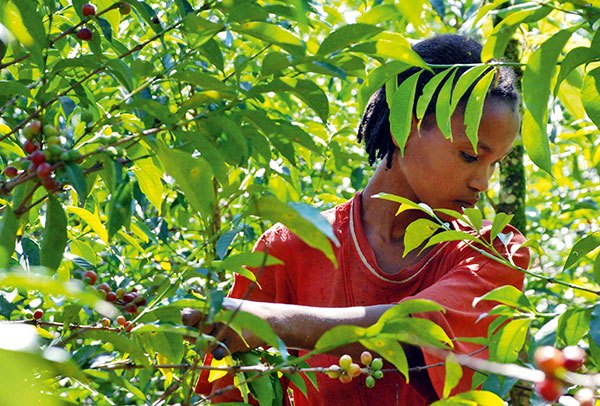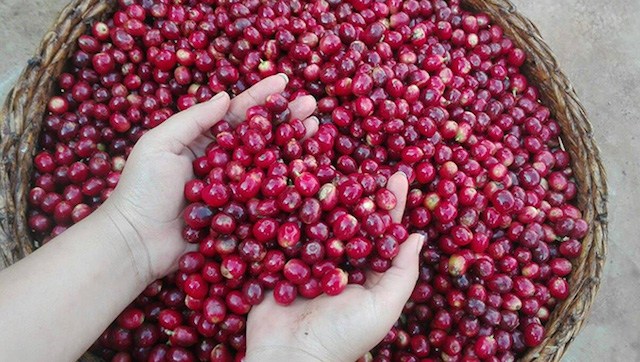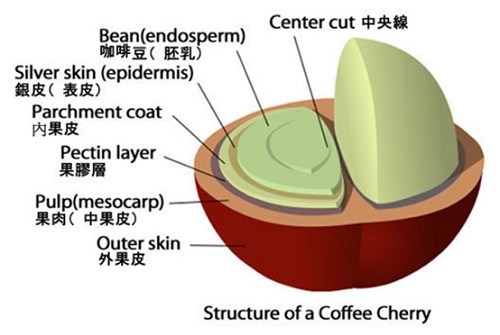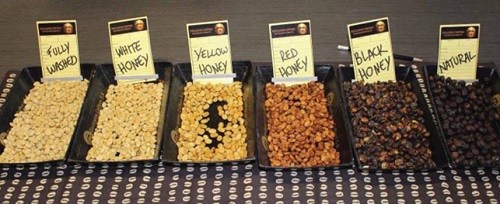The sun? Washing? Honey treatment? What exactly are you talking about when you are talking about the handling of coffee beans?

For professional baristas, please follow the coffee workshop (Wechat official account cafe_style)
1. Coffee fruit can be divided into six layers from outside to inside, namely, outer skin, pulp, gum, parchment, silver skin and seed. The difference between different treatments lies in the different methods of removing the outer coating of beans.
2. Dry treatment
3, do not remove any layer, directly take the whole beans to dry, mainly by the sun exposure (sometimes assisted by a dryer), commonly known as the sun drying method.
4. Wet treatment
5. First remove the skin and pulp, then eliminate the stickiness of the gum with the help of fermentation, then rinse the pectin with water, and then dry it. The drying process usually uses the sun and sometimes a dryer, which is commonly known as the washing method.
6. Semi-dry treatment can be divided into two categories:
7. (a) peeling and tanning
8. remove the exocarp, pulp and most of the gum, without fermentation, together with the residual gum to dry, this method is commonly known as semi-washing method.
9. (B) Honey treatment
10. Remove the exocarp and pulp, but deliberately retain part of the gum, make the gum undergo slight fermentation in a slower drying way, add acidity and sweetness in the bean, and then dry it. According to the quality of retained glue, it is called black honey, red honey, yellow honey and white honey respectively.
Very few agricultural products, like coffee, go through so many steps from a seed in the soil to drinking it, from selecting varieties, planting, caring, harvesting, processing, transporting, roasting, to preparing a cup of coffee, if it is not done well enough, it will damage the final flavor.
When most people drink a good cup of coffee, they usually only thank the caregiver (maybe themselves) of the cup of coffee. Occasionally, they may think that the baker also takes credit, but few people think that without the hard work of planting and care, without the details such as the careful handling of the coffee fruit after harvest, the current sense of contented happiness cannot be produced. In all previous gatherings of the May 4th Coffee Club, I have repeatedly stressed to members that in pursuit of good flavor, we must not only rely on the methods of the conditioner, but also have some understanding of each link, so that when we choose coffee, we will know what kind of coffee to look for, where to produce it, and how to treat it.
People who come into contact with coffee for the first time often mistakenly think that coffee beans (coffee bean) are beans, because bean means beans. In fact, coffee beans are not beans, they are drupe, the seeds of coffee tree fruit. The ripe fruits of coffee trees are similar to cherries, but more like cranberries (figure 1), known as coffee cherries (coffee cherry), while the so-called processing, in the professional field, refers to the process of turning picked coffee cherries into raw coffee beans.

Fig. 1 freshly picked coffee cherries
To introduce the treatment, we should first find out the structure of the coffee cherry and see which layers of substances the coffee beans are coated with. Only in this way can we understand that the different treatment methods are precisely due to the different methods of removing these coating layers.
Under normal circumstances, there are two seeds inside the coffee cherry, the adjacent part of the seed is flat, and the non-adjacent part is protruding oblate [Note 1], as shown in the profile (figure 2).

Fig. 2 Coffee cherry profile
Coffee cherries can be divided into six layers from the outside to the inside, namely, exocarp, pulp, gum, parchment, silver skin, and seeds.
1 exocarp
The outermost layer is the exocarp (epicarp), or skin for short, which is similar to but stronger than the outer skin of cherries or cranberries. In most coffee varieties, the skin is red when the fruit is ripe, but some are yellow or orange.
3 flesh
4 there is a thin layer of pulp (pulp) under the exocarp. In addition to dry treatment, the outer skin is usually removed within a few hours after the fruit is picked, and the pulp adhering to the inside is also removed, so the earliest peeling machine is called depulper.
5 colloid
6 under the pulp is the pectin layer (pectin layer), that is, colloid (mucilage). The gum is sweet and sticky, and coffee farmers like to call it Miel. In botany, pulp and colloid are collectively called mesocarp (mesocarp).
7 parchment paper
Under the colloid, the layer that is tightly adhered to by the colloid is a shell of cellulose (cellulose). Each coffee bean has a shell, which is the endocarp (endocarp). When the endocarp is dry, it looks like western parchment, so it is called parchment.
9 silver leather
10 Coffee beans are wrapped inside the parchment, and the bean surface is tightly covered with a very thin film, much like glutinous rice paper, which is the epidermis left by seed development, which is called silver skin or chaff in the coffee world. Most of the silver skin will fall off in the process of treatment (especially when washing), and sometimes the silver skin will be removed by the process of "polishing" before shipment. Even without the addition of this procedure, the few silver skins left will generally fall off during baking, leaving only a very small amount of debris in the slits in the middle of the bean, which will be mixed in the powder in the form of yellowish crumbs when the coffee beans are ground.
11 seeds
12 wrapped in the silver skin is the endosperm (endosperm), commonly known as seed (seed), that is, our protagonist, coffee beans (coffee bean).
Now we can talk about how to deal with it, but first of all, this article is only a key introduction, some minor changes are limited to space, and we can only wait for the opportunity to add them in the future. However, I am confident that anyone who has read this article will have a clear understanding of the overall concept of dealing with it.
Treatment can be divided into three categories: dry treatment, wet treatment and semi-dry treatment, which are explained item by item below.
Method 1: dry treatment (dry processing)
This is an ancient method commonly known as "tanning". To put it simply, the picked coffee cherries are exposed directly to the sun without removing a single layer, until the water content of the beans drops to 10.5-12%. If there is plenty of sunshine, this method saves the most energy, and if there is not enough sunlight or other reasons, it is possible to use a dryer to dry all or part of the process. Since the drying process does not necessarily have to go through the sun, it is professionally called "dry treatment" instead of "sun exposure". Of course, exposure to the sun is still the mainstream of dry treatment. Coffee-producing countries such as Ethiopia, Yemen and Brazil all use the sun method of more than 80%, and many other producing countries also use this method, especially in places where water resources are scarce. There are several points to be added about dry treatment:
If you use sun drying, it usually takes 2 to 4 weeks or more, depending on the weather and the flavor you want to show. Care must be taken when drying, not only to avoid excessive temperature, but also to avoid moldy beans or bad smell caused by excessive fermentation.
2 if the dryer is used to dry, the control of various factors will be easier, and the drying speed will be faster than that of the sun, but it will increase the cost of machine and energy, and the flavor is usually not as good as that of beans exposed to the whole sun.
(3) the dried fruit is usually stored with all the coatings, and the coating on the outside of the coffee bean is not removed mechanically until it is ready for shipment. this process is called dry milling.
(4) the length of drying time and the level of temperature will affect the flavor of coffee in different degrees. For example, in a stronger sun and drier environment, without special control, the gum may have been dried before fermentation, thus reducing the fruity and sweetness that is brought into the coffee beans due to moisture and slight fermentation, and the beans have no special characteristics. like most Brazilian commercial beans, this is one of the reasons why sun beans have a bad reputation. If the drying time is prolonged and the temperature is properly controlled to allow the coffee fruit to undergo slight fermentation, the beans will have a changeable fruit smell [Note 3]. In short, the complex fruit aroma is the standard mark of exquisite sun-dried beans, which is inferior to other treatments. However, there are also a small number of coffee professionals do not like the dry treatment, do not think that the extra fruity of coffee is a good flavor, but regard it as "pollution."
Method 2: wet treatment (wet processing)
Also known as the "washing method", it was developed by the Dutch in the 18th century. The Dutch developed this method because the colonies (such as Java) were wet and rainy, lacked continuous sunlight, and it was difficult to implement the sun method (there was probably no dryer in those days). The traditional practice is like this: first remove the outer skin and pulp of coffee cherries, then ferment the shell beans with glue in a tank, so that the sugar in the gum decomposes and the stickiness disappears, and then rinse off all the residue outside the parchment with clean water [Note 4]. Finally, take it to dry. Due to the lack of pericarp, pulp and gum, the drying time is greatly shortened. The following is a supplementary explanation on wet treatment:
1 the time for fermentation to be completed ranges from 12 hours to 6 days, which is related to the temperature at that time, the number of yeasts, and the methods used. For example, if you use Kenyan water washing (Kenyan method), it will take several days to go through more than one fermentation and flushing cycle.
2 deciding when to stop fermentation is a very important key in water washing. If the fermentation is not complete, the colloid will not be easily washed, and if it is fermented too much, the coffee will be smelly and sour.
(3) in the traditional washing method, when washing the residues of parchment, a large amount of clean water is needed, which is easy to cause environmental pollution, but now there have been innovations in industrial technology, for example, water is filtered and recycled, or water flushing is replaced by a rubbing machine. Water consumption can be greatly reduced, which is why it is professionally called "wet treatment" instead of "water washing".
4 there is a characteristic of wet-treated coffee: part of the acid produced in the process of gelatinous fermentation will enter into the beans, and at the same time, because there is no pulp and gum attached to the parchment during drying, the unique fruit aroma of sun-dried beans is less. the flavor tends to be clean and bright, and the acidity is more obvious.
Method 3: semi-dry treatment (semi-dry processing)
This is a method between dry and wet treatment, which can be divided into two categories: peeling and tanning and honey treatment. The two kinds of treatments are basically very similar, first, like wet treatment, removing the outer skin of coffee cherries, but skipping the wet treatment of "pool fermentation, rinsing with clean water" process and directly drying in the sun. Although the methods seem to be similar, because of one of the important differences, there are two very different flavors, which are worth explaining separately.
(a) peeling and tanning (pulped natural)
This is a method developed by Pinhalense, a Brazilian coffee equipment manufacturer, in the 1980s and 1990s. After many experiments, Pinhalense developed a modern peeling machine (depulper, also known as pulp separator), which squeezes the seeds out of ripe coffee fruit and uses a high-tech pressure cleaner (high-tech pressure washing machine) to remove the gum as much as possible, and then dry it to the desired extent. Due to the lack of fermentation process, the risk of overfermentation or underfermentation is reduced, and the quality of coffee beans tends to be consistent, but it is also because of this process that the flavor of coffee is a bit monotonous. As a result, high-quality coffee is rarely processed in this way. This treatment uses much less water than the water washing method, and some of the methods are similar to the wet treatment (removing the peel and pulp) and some are similar to the dry treatment (without fermentation in the pool), so it is also called semi-washing (semi-washed method). Incidentally, in Brazil and Colombia, one or two companies have registered patents with high-pressure automatic cleaning equipment, forming a quasi-monopoly in the market.
(B) Honey treatment (miel method)
Honey treatment (often written in English as honey proces) is a partially improved method based on peeling and tanning. It is now popular in Costa Rica and El Salvador, and is gradually popular in Central America and even spread to coffee-producing countries all over the world. The origin of the name is that beans deliberately retain part of the gum (honey) in the drying process. Its origin and methods are as follows: in the 1990s, Costa Rica developed a pectin scraping machine (demucilager) to replace the Brazilian pulp separator (depulper). The difference between the two machines is that the pectin scraper can adjust the pressure and caliber in the process of peeling. Retain some or all of the gum of the coffee beans, and then take the beans together with the gum to the sun (gelatinized beans cannot be dried by machine and must bear the risk of overfermentation or mildew). Because in the drying process, the gum will ferment for a short time, the coffee beans add a little acidity, and a little sugar in the gum seeps into the beans, making the coffee a little more sweet, which is not found in the Brazilian peeling and tanning method. Some handlers even refer to their coffee as 40%, 60%, 80% or 100% honey-treated beans, depending on the amount of gum retained, but probably have reservations about this, because it is virtually impossible to make it so accurately. Nowadays, it is more popular to use color instead of percentage. there is a difference between black honey, red honey, yellow honey and white honey (see figure 3). The more colloid is retained, the darker the dried beans are, and the more similar the flavor of coffee is to sun-treated coffee.

Figure 3 from right to left, sun, black honey, red honey, yellow honey, white honey, and whole water washed beans
Before concluding this article, I would like to express some personal feelings. In my opinion, with the progress of science and technology, the treatment method is bound to have innovation in the future, just like the washing method and semi-washing method degenerated from the traditional solarization method; or some strange methods caused by social and environmental factors (such as Sumatra wet planing method, bird and animal excreta treatment method not introduced in this article), as well as wine treatment, cinnamon treatment developed in recent years, etc. Who knows in a few days, some wild and strange ideas will appear in the handling of coffee?
[note 1] Coffee cherries usually have two seeds, with exceptions. For example, when one of the two seeds is sterile and only the other seed grows and occupies all the developmental space, a round bean (Peaberry) is formed; in addition, there are conical beans with more than two seeds. Conical beans are relatively rare, while round beans usually account for about 5% of the total harvest, and round beans are usually smaller.
[note 2] Miel is Spanish, equivalent to Honey in English.
[note 3] if it is overfermented, it may produce a strong smell of tropical fruit or even decay.
[note 4] this is the origin of the name "washing method".
Important Notice :
前街咖啡 FrontStreet Coffee has moved to new addredd:
FrontStreet Coffee Address: 315,Donghua East Road,GuangZhou
Tel:020 38364473
- Prev

Small welfare | Coffee biscuit making tutorial sharing
Exchange of professional baristas Please pay attention to the afternoon tea time of the coffee workshop (Wechat official account cafe_style), have a cup of strong coffee to cheer you up, and warm your stomach with a piece of hand-made coffee biscuits, and then go on with your work. The market is full of different kinds of biscuits, but the news page is full of food safety warnings, restraining appetite for the sake of good health, and sometimes making too hungry instead.
- Next

New enjoyment in the morning: two steps to teach you to finish cold coffee
The exchange of professional baristas please follow the coffee workshop (official Wechat account cafe_style) Coffee culture has been dominant in recent years, and cold coffee has become a hot topic in recent years. Cold coffee is a perfect combination of stronger coffee, more caffeine and less bitterness than ordinary hot coffee after 12 hours of soaking overnight. This one sounds like a fair fee.
Related
- What is the meaning of lactic acid fermentation with coffee bean treatment?
- How to judge the state of foam by sound?
- How does the latte pull out the unicorn pattern? Come to get for a little trick to improve the flower pull!
- Will flower pulling affect the taste of the latte?
- Do you know the history of coffee?
- The difference between honey treatment and sun washing what is raisin honey treatment?
- What kind of milk can a novice use to make coffee foam to keep the foam longer? The correct method and skills of milking tutorial sharing
- Why do washed coffee beans taste sour? Flavor characteristics of washed Coffee
- Introduction to the skill of how to practice the size and height of water injection around the circle of hand-brewed coffee
- How do beginners practice coffee flower drawing from scratch?

